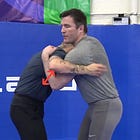Connection, duh?
Connection refers to the physical connection between a person, their opponent and the surfaces they grapple on.
All grappling martial arts need a degree of physical connection to work. It is tempting to view two people grappling and conclude that the only connection in play is between each other but this neglects the bigger picture. We also need to consider our connection to the ground or more generally the surfaces we are in contact with. If you’re wondering what more surfaces other than the ground could possibly exist, consider the sport of MMA where the fence exists adding a new dimension to grappling. This isn’t a particularly insightful or sophisticated conclusion to draw but this simple principle encapsulates so many concepts that are key to understanding why, how and what we connect to when we grapple.
When we start thinking with connection in mind, we develop a framework with a central theme in mind that we can apply when learning about new positions and situations.
A Framework of Connection Focused Thinking
Here is a sample framework of thinking drawn up with connection in mind. You can use this framework to help understand new positions/situations:
What is our goal in making connection?
Asking this question at the start provides the necessary context that guides the rest of the framework. We need a clear goal and understanding as to why we are forming connection in order to not meaninglessly connect and risk being exploited. For example, an answer to this question could be that that I am connecting to my opponent as I wish to pass their guard.
Why are we forming this particular connection?
In asking this question we understand the purpose of this connection. Specifically, the physical or tactical benefits it provides us in pursuit of our goal. We can learn about different types of grips and their purpose, for example the cross face which wedges our opponent’s head in place and restricts movement in one direction.
Where on the body or contact surfaces do we connect to?
Usually there are Focal Points on the human body that are ideal to connect to as they confer some physical or strategic advantage. John Danaher’s idea of a smart traveller relates to us the idea that when someone goes to pick up a suitcase, they always pick it up at the handle and not somewhere random.
The ground is always at play and cannot be neglected in our understanding of connection. The ground plays an important role regardless of top or bottom position. We generate force by pushing off the ground as the person on the bottom while we exploit the connection our opponent has to the ground to pin them when we are on top.
How do we make these connections?
This question is about the method we use to form these connections against resistance. From our earlier questions, we should assume our opponent is thinking the same way if they are intelligent and will deny us the connection we desire. Thus we need to come up with methods to attain these grips which can involve a hand/grip fighting phase. How we grip fight will change from situation to situation but there will always be a degree of misdirection and combining attacks to achieve our desired connection.
When does my connection become a liability?
Thus far we have talked about connection being a positive means to achieve a particular end. We now need to pivot into another direction and consider when it is appropriate to DISCONNECT. BJJ is dynamic in nature which means connections formed at one point in time for a purpose maybe become redundant and become a liability should circumstances change.
Example: An extended arm from bottom seated guard has an element of being overextended. The top person can exploit this connection to attack us with an armbar.
Concepts Under Connection
Here are some concepts that fall under connection
Inside Position
Owning the shortest distance between two points. For a detailed explanation please read my other post here:
Overextension
Having a part of your body vulnerable to attack due to distance from ‘defensive lines’ (e.g. one arm separated and unable to be rescued by another).
Head Control (Cranial Shift/Control)
Where the head goes the body must follow. Head control is really controlling the long end of the lever which is your spine. We are able to restrict movement by controlling the head.
Grip Fighting
There will be a battle to make connections. Whoever wins the grip fight to make their connection usually dictates the setups and in turn the pace of the match.
Conclusion
By no means are the five questions above the only way to form a framework of thinking based around connection. However, I believe that these five questions cover enough breadth to assist you meaningfully when encountering new positions and situations.


